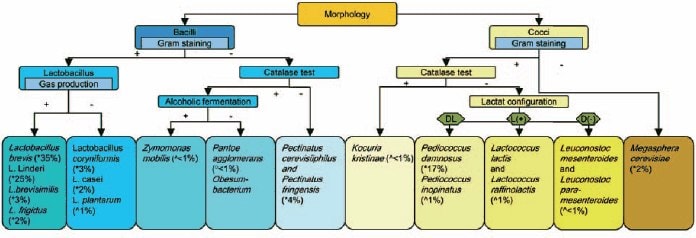Culture Method for Beer Quality Control
The classical cultural method for the quality control of beer is still important. Most modern use at least a pre-enrichment step and the costs for the analysis are lower. Traditional methods are based morphology, staining methods, enzyme reactions (metabolism) and diverse media. One of the first steps is the filtration of the beer followed by an incubation of the filter on an agar plate. Suspect colonies are then examined under the microscope followed by staining procedures and biochemical tests. More details of a systematic identification can be seen in Figure 1.

Figure 1. Identification flow chart for beer spoilage bacteria. * obligate beer spoilage. ^ potential beer spoilage. ° indirect beer spoilage. Numbers in % gives the frequency of spoilage organisms from quality complaints for beer (1980-2002)1
Listed in Table 1 are the typical media used for the detection of spoilage organisms like lactobacilli, pediococci, Pectinatus, Megasphaera molds and wild yeasts in the brewery and fermentation industry. Only a few genera of bacteria, wild yeasts, and molds cause spoilage of beer and wine because of the alcohol content, low pH, and other ingredients having inhibitory effects. Some of these contaminants can interfere with fermentation or have deleterious effects on flavor and shelf life. Most of these spoilage organisms make the beer acidic or producing substances with a bad taste like diacethyl and tetraden compounds. Pectinatus and Megasphaera are also dangerous pathogens.
References
To continue reading please sign in or create an account.
Don't Have An Account?